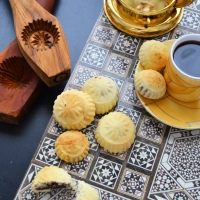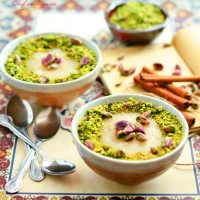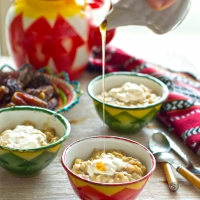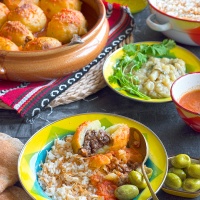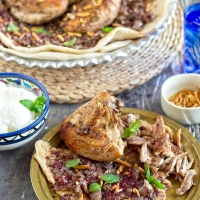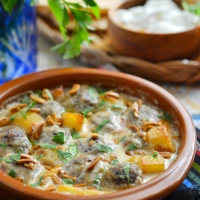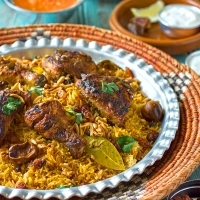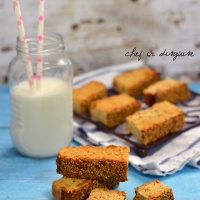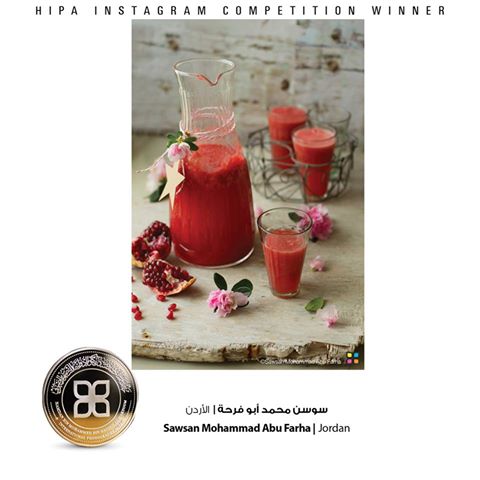Looking for a fancy,show-stopping dessert that you can make ahead of time without all the stress of last-minute preparations?
Try madlouka
As we approach the middle of Ramadan, family get-togethers and friendly iftar’s are something I personally look forward to. You are done with the formal invitations and the race for who invites who first that happens in the first week and it is now time to slow down and soak up the true meaning of Ramadan with those you care for the most. What better way to end a meal than with a dessert that is easy to make, stress-free yet looks elegant and plays on the flavour notes that everyone loves?
What is Madlouka مدلوقة?
The name madlouah or madlooka (madlouqa) comes from the Arabic word dalak which means to pour and when you check out the steps you will understand why it was given the name.
Simply put, Madlouka is a no-bake knafeh dessert popular in the beautiful city of Nablus, the hometown of Knafeh. It is really super simple to make with only 4 basic ingredients (5 if you count the rose petals) yet the end result is a real show-stopper.
What does Madlouka taste like?
Taking a bite of madlouah will send your taste buds on a wild ride of flavors! knafeh dough is toasted in a bit of ghee to add a nutty richness then it is cooked to perfection in orange blossom-scented syrup. Next comes the velvety smoothness of the cream, the zing of the pistachios and the perfect finish, delicate aromatic rose petals.
All in one amazing bite 🙂

What is Ashta?
Ashta is Arabic for cream but this is a special kind of cream not your typical store-bought one. it is actually clotted cream. If you have ever simmered fresh raw milk at home( and even with store-bought bottled milk) and then set it aside, you would notice that a film forms on the surface of the milk.That film is actually the cream that rises to the surface and solidifies as it cools. That film’s thickness depends on the fat content in the milk. It is thicker in full-fat raw milk than in reduced-fat or homogenized store-bought milk. That rich, thick and creamy surface layer is Ashta. It the star of many Arabic traditional desserts because of its richness, unique flavour, and texture.
Where can I find Ashta and what are the replacements for it?
- You can still buy authentic ashta nowadays from certain stores but it is hard to come by (you’d have to preorder it in advance) and it is rather expensive. You see, sadly as cities got bigger, farms and raw milk became the exception, not the rule.That being said,if there is a farm near you or if you know of any stores that sell raw milk (if that is legal where you live) try making your own. It is really a simple process of simmering milk and straining the topping.
- Look for stores that offer clotted cream. Clotted cream is the result of simmering cream then allowing it to cool for the surface cream layer to “clot”
- Make mock ashta. In this post, I am sharing my favorite recipe for mock ashta . It is as close as possible to the original texture and taste of authentic Ashta

What is Ater?
Ater is sugar syrup. It is used in many traditional Arabic desserts. Think knafeh, basbousa, halawet jeben and the list goes on and on. It is basically a sugar syrup made with 1:1 ratio for certain desserts and 2:1 or 3:2 sugar to water for others if a thicker consistency is desired for that particular dessert. It is usually scented with orange blossom water or spices like cinnamon or cardamom but that is optional
Madlouka (the ultimate no bake knafeh dessert)
3 cups farek knafeh (knafeh dough)
3 tablespoons ghee
2 cups syrup
Ashta topping
Rose petals and crushed pistachios for decoration
- In a pot over medium heat add farek knafeh and ghee
- Stir occasionally till the farek is the ghee is milted and the farek(knafeh dough) is lightly toasted

- Add the syrup and stir gently till the farek absorbs all of the syrup

- Pour the mixture into your serving plates. You are aiming for a thin layer about 1 inch(2.5cm) in thickness
- Spread a thin layer of ashta topping

- Decorate with rose petals for flavour and a pop of colour
- Serve with extra syrup for those who enjoy things extra sweet
To make the ashta (cream topping)
2-liter milk
1/2 cup vinegar
1 can cream
1 teaspoon orange blossom water(optional)
- In a pot place your milk and bring it up to a simmer
- when you see bubbles form around the edges add the vinegar, stir and turn off the heat. You will notice that the milk will split and curds will form. Set aside for 10 minutes

3. Strain the milk using a strainer or a cheesecloth

4.Mix the resulting curds with table cream and orange blossom water (optional) if using.
5.Allow to cool then store in an air tight container in the fridge for up to 3 days
To make the sugar syrup (kater/ater)
3 cups sugar
2 cups water
1 tablespoon lemon juice
1 teaspoon orange blossom water (optional)
In a pot over medium heat place the sugar, water and lemon juice
Bring to a boil then lower the heat and simmer for 5 minutes
Take off the heat and add the orange blossom water if using

FAQ
Can I make the Knafeh dough (farek) at home?
Yes, you can find the detailed recipe here
How long can I store the leftovers?
You can store the leftovers in the fridge for 3-5 days
Can I use butter instead of ghee?
Yes, you can use coconut oil too
Can I skip the orange blossom water?
Yes, the orange blossom water is optional
The cream
The dough
the sugar syrup




